<< Back to Nanoscience at Emory
Nanolab highlight archive
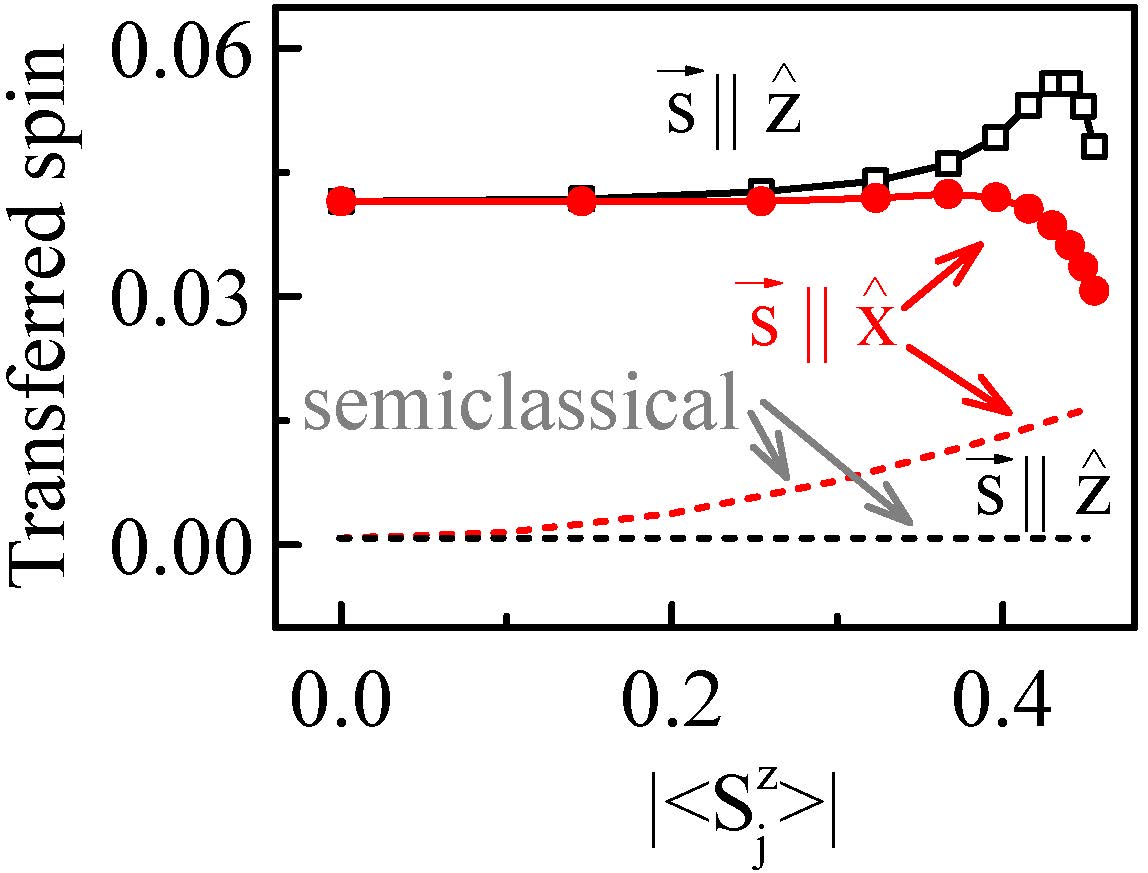 “Non-classical spin transfer effects in an antiferromagnet”, PRL 2021.
We utilize simulations of electron scattering by a chain of quantum spins, to demonstrate large contributions to the spin transfer effect in antiferromagnets
(AFs) that cannot be accounted for by the existing semiclassical models of magnetism. AFs are attractive for the development of novel nanomagnetic devices,
since their vanishing magnetization and high characteristic dynamical frequencies may enable fast and low-power device operation. Spin transfer effect – the
transfer of angular momentum from the conduction electrons to the magnetic system – plays a central role in such devices, enabling electronically-driven
rotation of magnetic order. Our results demonstrate the possibility to achieve a substantial enhancement of spin transfer efficiency by taking advantage of
non-classical effects, and suggest the possibility to utilize spin transfer to control purely quantum magnetic systems such as spin liquids.
“Non-classical spin transfer effects in an antiferromagnet”, PRL 2021.
We utilize simulations of electron scattering by a chain of quantum spins, to demonstrate large contributions to the spin transfer effect in antiferromagnets
(AFs) that cannot be accounted for by the existing semiclassical models of magnetism. AFs are attractive for the development of novel nanomagnetic devices,
since their vanishing magnetization and high characteristic dynamical frequencies may enable fast and low-power device operation. Spin transfer effect – the
transfer of angular momentum from the conduction electrons to the magnetic system – plays a central role in such devices, enabling electronically-driven
rotation of magnetic order. Our results demonstrate the possibility to achieve a substantial enhancement of spin transfer efficiency by taking advantage of
non-classical effects, and suggest the possibility to utilize spin transfer to control purely quantum magnetic systems such as spin liquids.
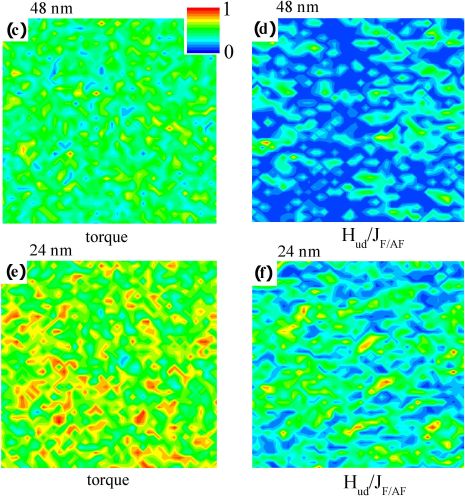 “Exchange bias without directional anisotropy”, PRB 2021.
This paper addresses the 60+ year-old problem of exchange bias (EB) - directional anisotropy of magnetic hysteresis loop observed in ferromagnet/antiferromagnet (F/AF) bilayers.
Traditionally, this effect is explained by the unidirectional anisotropy of F due to the uncompensated AF spins at the interface. We utilize a combination of several experimental techniques and simulations
to demonstrate, for a classic F/AF system formed by AF=CoO and F=Permalloy, that the unidirectional anisotropy is vanishingly small. We show the EB is likely caused by the hotspots of twisted local magnetization,
which serve as nucleation centers biasing the magnetization reversal. The Figure on the left shows the results of the simulations of torques exerted on the magnetization of F with two different thicknesses, as well as the simulated distribution of unidirectional anisotropy.
Suprisingly, the torquess and the anisotropies strongly depend on the thickness of F, which can be explained by the 2d-to-3d dimensional crossover of its response to random interfacial fields,
as demonstrated in our previous work. Our findings facilitate the efforts to develop memristive memories taking advantage of multistable magnetization configuraitons in F/AF-based heterostructures.
“Exchange bias without directional anisotropy”, PRB 2021.
This paper addresses the 60+ year-old problem of exchange bias (EB) - directional anisotropy of magnetic hysteresis loop observed in ferromagnet/antiferromagnet (F/AF) bilayers.
Traditionally, this effect is explained by the unidirectional anisotropy of F due to the uncompensated AF spins at the interface. We utilize a combination of several experimental techniques and simulations
to demonstrate, for a classic F/AF system formed by AF=CoO and F=Permalloy, that the unidirectional anisotropy is vanishingly small. We show the EB is likely caused by the hotspots of twisted local magnetization,
which serve as nucleation centers biasing the magnetization reversal. The Figure on the left shows the results of the simulations of torques exerted on the magnetization of F with two different thicknesses, as well as the simulated distribution of unidirectional anisotropy.
Suprisingly, the torquess and the anisotropies strongly depend on the thickness of F, which can be explained by the 2d-to-3d dimensional crossover of its response to random interfacial fields,
as demonstrated in our previous work. Our findings facilitate the efforts to develop memristive memories taking advantage of multistable magnetization configuraitons in F/AF-based heterostructures.
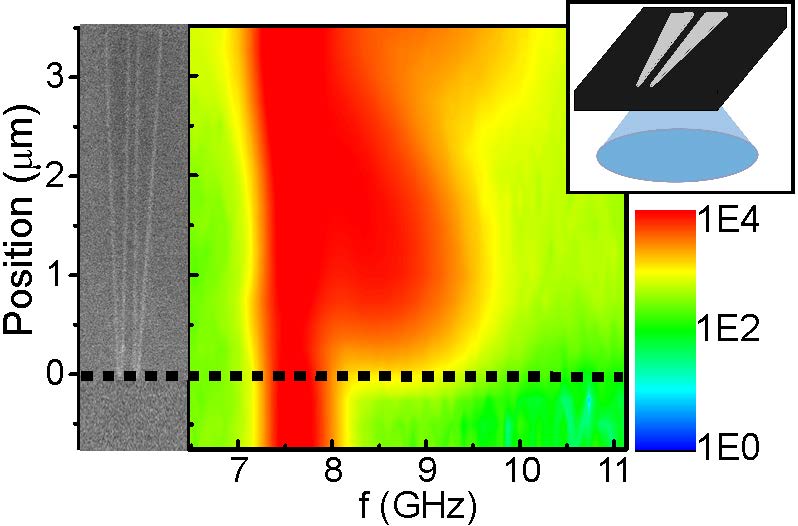 “Brillouin Light Scattering of Spin Waves Inaccessible with Free-Space Light”, Phys. Rev. Research (2020).
Inelastic light scattering techniques, such as Brillouin light spectroscopy (BLS), provide efficient tools for studies of elementary excitations, such as phonons or magnons, in a variety of materials.
However, the small momentum of light limits the accessible excitations to the center of the Brillouin zone. We utilize a metallic nanoantenna
fabricated on the archetypal ferrimagnet yttrium iron garnet to demonstrate the possibility of Brillouin light scattering from large-wavevector,
high-frequency spin wave excitations that are inaccessible with free-space light. The antenna facilitates sub-diffraction confinement of
electromagnetic field, which enhances the local field intensity and generates momentum components significantly larger than those of free-space light.
The approach we have demonstrated for spin waves can be generalized to other types of
excitations and light scattering techniques. It provides access to short-wavelength excitations that can be important for the development of fast nanoscale devices, where such
excitations are generally expected to play an important role.
“Brillouin Light Scattering of Spin Waves Inaccessible with Free-Space Light”, Phys. Rev. Research (2020).
Inelastic light scattering techniques, such as Brillouin light spectroscopy (BLS), provide efficient tools for studies of elementary excitations, such as phonons or magnons, in a variety of materials.
However, the small momentum of light limits the accessible excitations to the center of the Brillouin zone. We utilize a metallic nanoantenna
fabricated on the archetypal ferrimagnet yttrium iron garnet to demonstrate the possibility of Brillouin light scattering from large-wavevector,
high-frequency spin wave excitations that are inaccessible with free-space light. The antenna facilitates sub-diffraction confinement of
electromagnetic field, which enhances the local field intensity and generates momentum components significantly larger than those of free-space light.
The approach we have demonstrated for spin waves can be generalized to other types of
excitations and light scattering techniques. It provides access to short-wavelength excitations that can be important for the development of fast nanoscale devices, where such
excitations are generally expected to play an important role.
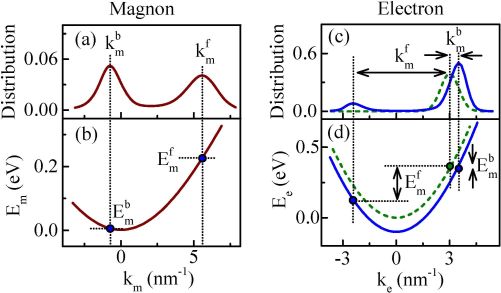 “Energy and momentum conservation in spin transfer”, PRB 2020.
The advent of spin transfer effect - the transfer of angular momentum from the current-carrying conduction electrons to magnetization in magnetic nanostructures
– has transformed our understanding of magnetism, and led to the development of novel magnetoelectronic nanodevices. This effect is presently understood
as a consequence of angular momentum conservation, but the role of the other two fundamental conservation laws, of linear momentum and energy - has remained a puzzle for over 20 years.
We utilized quantum simulations to demonstrate that the laws of energy and momentum conservation substantially constrain the dynamical magnetization states
induced by ST, as well as the resulting orbital and spin dynamics of electrons. Our findings provide a conceptually new framework for the analysis of ST,
scattering of electrons by magnetic materials, and other related magnetoelectronic phenomena. These findings may provide a route for the development of
novel laser-like magnetic nanodevices, where specific magnetic modes singled out by energy and momentum conservation are excited by spin transfer.
“Energy and momentum conservation in spin transfer”, PRB 2020.
The advent of spin transfer effect - the transfer of angular momentum from the current-carrying conduction electrons to magnetization in magnetic nanostructures
– has transformed our understanding of magnetism, and led to the development of novel magnetoelectronic nanodevices. This effect is presently understood
as a consequence of angular momentum conservation, but the role of the other two fundamental conservation laws, of linear momentum and energy - has remained a puzzle for over 20 years.
We utilized quantum simulations to demonstrate that the laws of energy and momentum conservation substantially constrain the dynamical magnetization states
induced by ST, as well as the resulting orbital and spin dynamics of electrons. Our findings provide a conceptually new framework for the analysis of ST,
scattering of electrons by magnetic materials, and other related magnetoelectronic phenomena. These findings may provide a route for the development of
novel laser-like magnetic nanodevices, where specific magnetic modes singled out by energy and momentum conservation are excited by spin transfer.
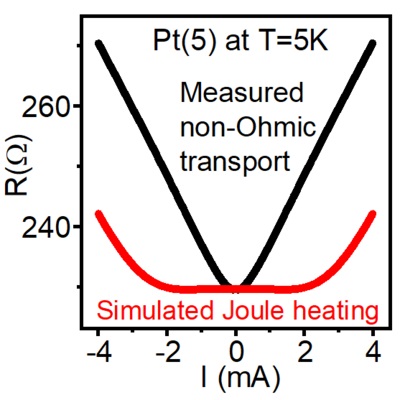 “Observation of Anomalous Non-Ohmic Transport in Current-Driven Nanostructures”, PRX 2020.
The idea of Joule heating - an increase of temperature due to the electrical current flowing through materials or devices - has been a paradigm in condensed matter physics for almost two centuries.
At the microscopic level, current-driven electron scattering on impurities and phonons results in phonon generation. The resulting phonon distribution may not be adequately described by a temperature as implied by the Joule's heating law.
We have demonstrated that the current-driven phonon distribution in a variety of metallic microstructures is qualitatively different from that expected for Joule heating, as manifested by a weakly-singular linear dependence of resistance on current.
Our results suggest that it may be possible to optimize thermal dissipation in nanodevices beyond the limits set by the Joule heating law.
“Observation of Anomalous Non-Ohmic Transport in Current-Driven Nanostructures”, PRX 2020.
The idea of Joule heating - an increase of temperature due to the electrical current flowing through materials or devices - has been a paradigm in condensed matter physics for almost two centuries.
At the microscopic level, current-driven electron scattering on impurities and phonons results in phonon generation. The resulting phonon distribution may not be adequately described by a temperature as implied by the Joule's heating law.
We have demonstrated that the current-driven phonon distribution in a variety of metallic microstructures is qualitatively different from that expected for Joule heating, as manifested by a weakly-singular linear dependence of resistance on current.
Our results suggest that it may be possible to optimize thermal dissipation in nanodevices beyond the limits set by the Joule heating law.
Spin liquid in a thin-film ferromagnet/antiferromagnet bilayer
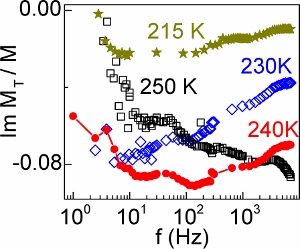 Among the general themes in modern science are the new fundamental phenomena and functionalities that emerge in "designer" materials and structures.
Is it possible to form a new magnetic state of matter by putting together two materials exhibiting well-known magnetic phases, such as a ferromagnet (F) and an antiferromagnet (AF)?
We gave a positive answer to this question in a series of papers,
PRB 2015, PRB 2016, and
PRB 2018, where we utilized time-domain measurements of magnetization aging
to demonstrate that a sufficiently thin AF film can turn into a magnetic glass. In our latest work, published in
JMMM 2019, we utilized variable-temperature,
variable frequency transverse magnetic susceptibility measurement developed in our lab [example in the Figure on the left], to demonstrate that the magnetization of AF undergoes
rapid freezing with decreasing temperature. The magnetic viscousity increases by four orders of magnitude within 20K temperature range, as expected for the magnetic glass transition.
The newly identified magnetic phase may become particularly useful for the development of neuromorphic magnetic devices, since it is expected to stabilize a multitude of magnetization states in nanomagnets.
Among the general themes in modern science are the new fundamental phenomena and functionalities that emerge in "designer" materials and structures.
Is it possible to form a new magnetic state of matter by putting together two materials exhibiting well-known magnetic phases, such as a ferromagnet (F) and an antiferromagnet (AF)?
We gave a positive answer to this question in a series of papers,
PRB 2015, PRB 2016, and
PRB 2018, where we utilized time-domain measurements of magnetization aging
to demonstrate that a sufficiently thin AF film can turn into a magnetic glass. In our latest work, published in
JMMM 2019, we utilized variable-temperature,
variable frequency transverse magnetic susceptibility measurement developed in our lab [example in the Figure on the left], to demonstrate that the magnetization of AF undergoes
rapid freezing with decreasing temperature. The magnetic viscousity increases by four orders of magnitude within 20K temperature range, as expected for the magnetic glass transition.
The newly identified magnetic phase may become particularly useful for the development of neuromorphic magnetic devices, since it is expected to stabilize a multitude of magnetization states in nanomagnets.
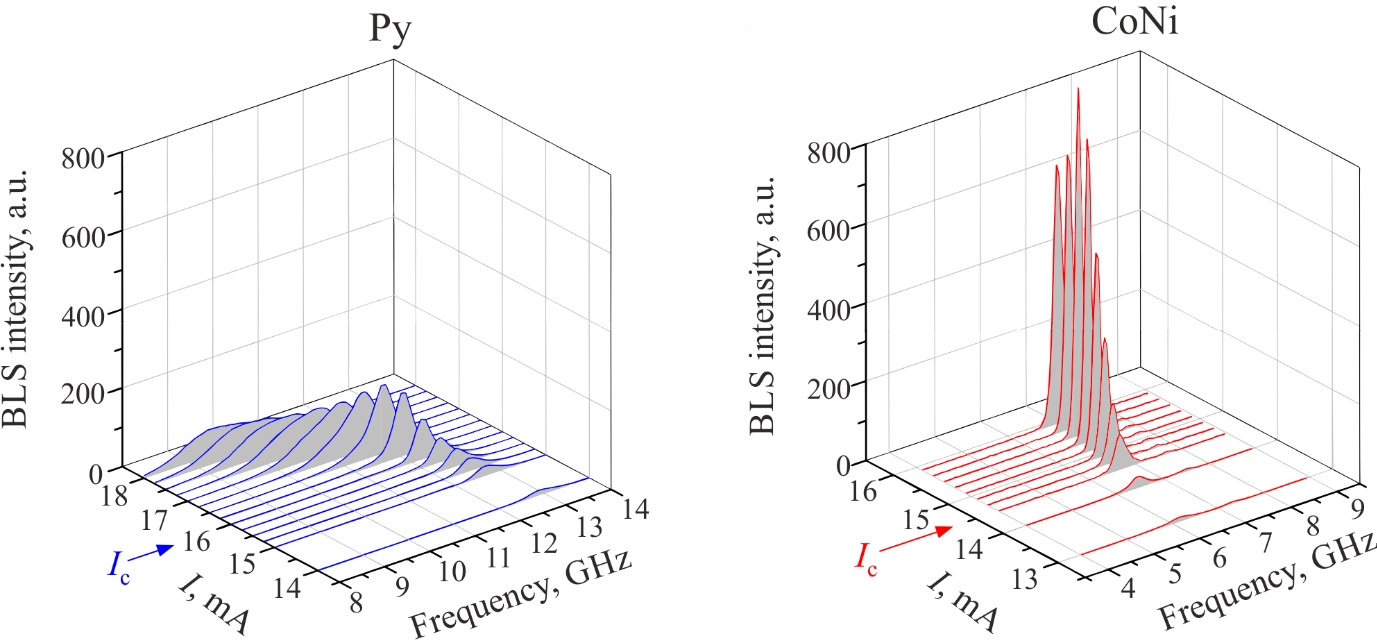 “Controlled nonlinear magnetic damping in spin-Hall nano-devices”, Nature Comm., 2019.
When the amplitude of oscillations in some dynamical systems become large, they start to experience nonlinear relaxation that
suppresses large-amplitude dynamics. Among many manifestations of this adverse effect, it has prevented the development of
efficient microwave oscillators based on magnetic materials. Until now, the mechanisms of nonlinear damping in magnetic
films have not been established. In collaboration with the
group of Sergej Demokritov at U.Muenster, we show that the nonlinear damping in magnetic films originates from
non-resonant parametric pumping associated with ellipticity of magnetization precession, and demonstrate how it can
be avoided to achieve large-amplitude magnetization oscillations driven by the spin Hall effect.
“Controlled nonlinear magnetic damping in spin-Hall nano-devices”, Nature Comm., 2019.
When the amplitude of oscillations in some dynamical systems become large, they start to experience nonlinear relaxation that
suppresses large-amplitude dynamics. Among many manifestations of this adverse effect, it has prevented the development of
efficient microwave oscillators based on magnetic materials. Until now, the mechanisms of nonlinear damping in magnetic
films have not been established. In collaboration with the
group of Sergej Demokritov at U.Muenster, we show that the nonlinear damping in magnetic films originates from
non-resonant parametric pumping associated with ellipticity of magnetization precession, and demonstrate how it can
be avoided to achieve large-amplitude magnetization oscillations driven by the spin Hall effect.
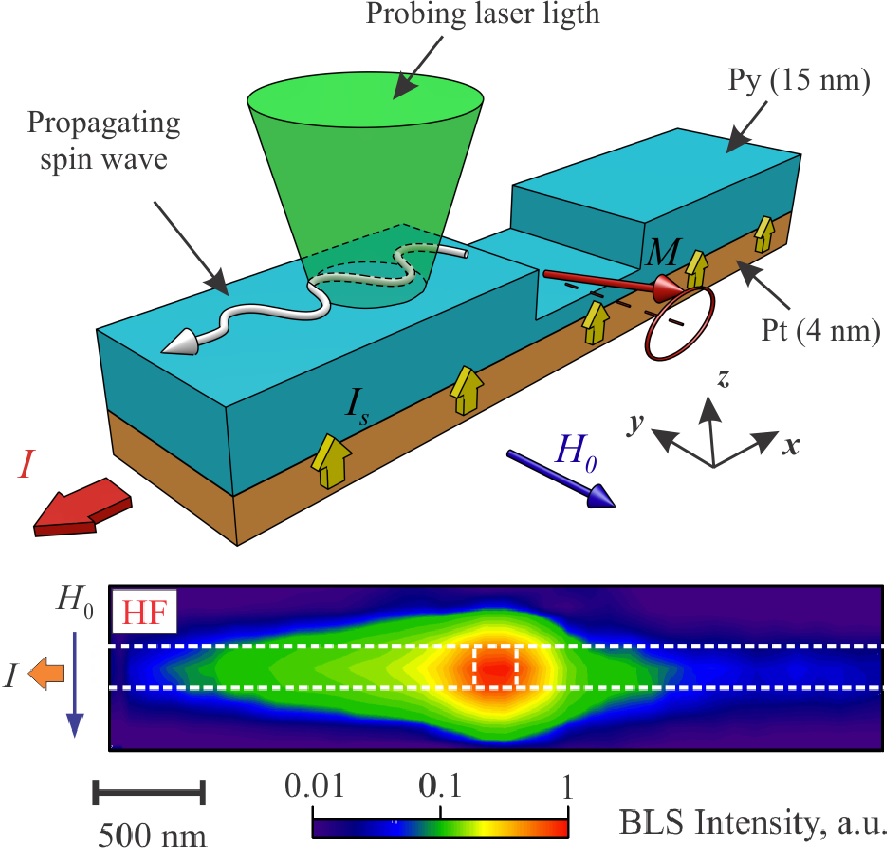 “ Excitation and Amplification of Spin Waves by Spin-Orbit Torque ”, Advanced Materials, 2018.
In collaboration with the group of Sergej Demokritov at U.Muenster,
we demonstrate the possibility to locally generate coherent spin waves, and to simulataneously enhance their propagation.
The developed nanostructure is based on a Permalloy/Pt nanowire, with a narrow notch. Magnetization oscillation is produced in the nano-notch regoin by the spin Hall effect in Pt,
resulting in emission of coherent spin waves into the nanowire. The propagation of spin waves in the nanowire is enhanced by the same spin Hall mechanism, resulting in the reduction of effective dynamical damping.
Surprisingly, the emission of spin waves is strongly asymmetric, opening the possibility to nonreciprocal spin wave-based magnonic and neuromorphic circuits
“ Excitation and Amplification of Spin Waves by Spin-Orbit Torque ”, Advanced Materials, 2018.
In collaboration with the group of Sergej Demokritov at U.Muenster,
we demonstrate the possibility to locally generate coherent spin waves, and to simulataneously enhance their propagation.
The developed nanostructure is based on a Permalloy/Pt nanowire, with a narrow notch. Magnetization oscillation is produced in the nano-notch regoin by the spin Hall effect in Pt,
resulting in emission of coherent spin waves into the nanowire. The propagation of spin waves in the nanowire is enhanced by the same spin Hall mechanism, resulting in the reduction of effective dynamical damping.
Surprisingly, the emission of spin waves is strongly asymmetric, opening the possibility to nonreciprocal spin wave-based magnonic and neuromorphic circuits
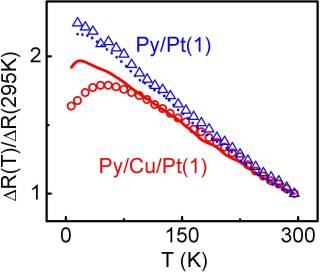 “Evidence for Dyakonov-Perel-like spin relaxation in Pt”,
Phys. Rev. Lett., 2018.
Spin-orbit interaction (SOI) plays a prominent role in modern spintronics, by providing the ability to control the
spin and the orbital electronic degrees of freedom. Materials with strong SOI, such as Pt, can efficiently generate spin currents, due to the
spin Hall effect (SHE). It is believed that SHE in Pt is determined mostly be the
band structure - the intrinsic SHE. However, until now it was believed that the spin relaxation in Pt, also determined by SOI, was caused entirely
by the electron scattering - the extrinsic mechanism. In this work, we experimentally demonstrate a significant, previously unrecognized intrinsic
spin relaxation mechanism complementary to the intrinsic SHE.
“Evidence for Dyakonov-Perel-like spin relaxation in Pt”,
Phys. Rev. Lett., 2018.
Spin-orbit interaction (SOI) plays a prominent role in modern spintronics, by providing the ability to control the
spin and the orbital electronic degrees of freedom. Materials with strong SOI, such as Pt, can efficiently generate spin currents, due to the
spin Hall effect (SHE). It is believed that SHE in Pt is determined mostly be the
band structure - the intrinsic SHE. However, until now it was believed that the spin relaxation in Pt, also determined by SOI, was caused entirely
by the electron scattering - the extrinsic mechanism. In this work, we experimentally demonstrate a significant, previously unrecognized intrinsic
spin relaxation mechanism complementary to the intrinsic SHE.
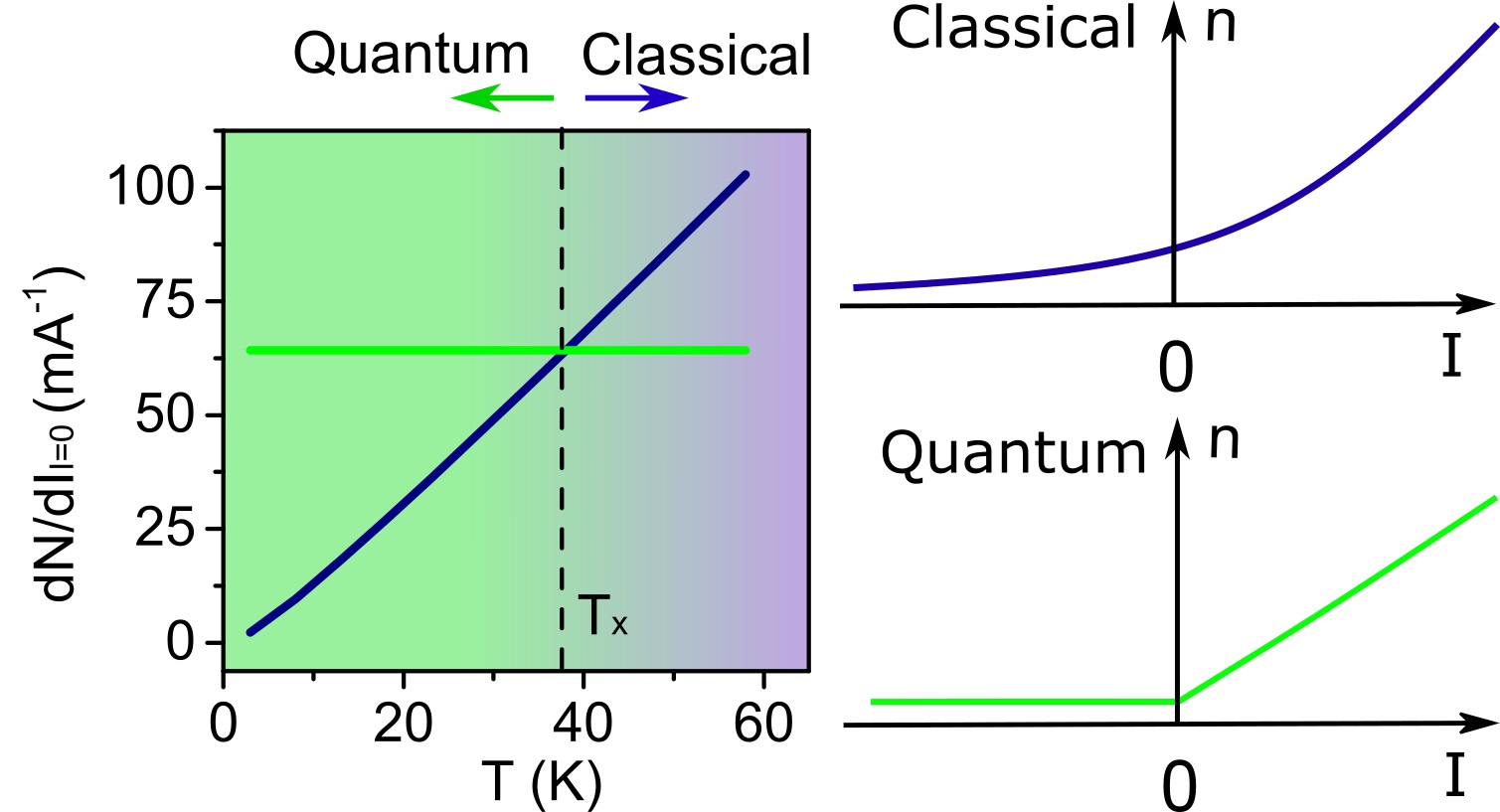 “Spin transfer due to quantum fluctuations of magnetization”,
Phys. Rev. Lett., 2017, featured in the PRL Viewpoint .
We expeirmentally demonstrate that the interaction between electron spins in electrical current and magnetization of ferromagnets can enhance not only thermal magnetization
fluctuations, but also its quantum fluctuations. This process can be driven not only by directional flows of spin-polarized current, but also by unpolarized currents
and by thermal motion of conduction electrons. Surprisingly, the observed quantum effect remains significant even at room temperature. It also entails a significant
and ubiquitous contribution to spin-polarizing properties of ferromagnets. These findings open a new chapter in our understanding of interaction between magnetic and
electronic degrees of freedom, and in applications utilizing control of dynamical magnetization states by electrical current.
“Spin transfer due to quantum fluctuations of magnetization”,
Phys. Rev. Lett., 2017, featured in the PRL Viewpoint .
We expeirmentally demonstrate that the interaction between electron spins in electrical current and magnetization of ferromagnets can enhance not only thermal magnetization
fluctuations, but also its quantum fluctuations. This process can be driven not only by directional flows of spin-polarized current, but also by unpolarized currents
and by thermal motion of conduction electrons. Surprisingly, the observed quantum effect remains significant even at room temperature. It also entails a significant
and ubiquitous contribution to spin-polarizing properties of ferromagnets. These findings open a new chapter in our understanding of interaction between magnetic and
electronic degrees of freedom, and in applications utilizing control of dynamical magnetization states by electrical current.
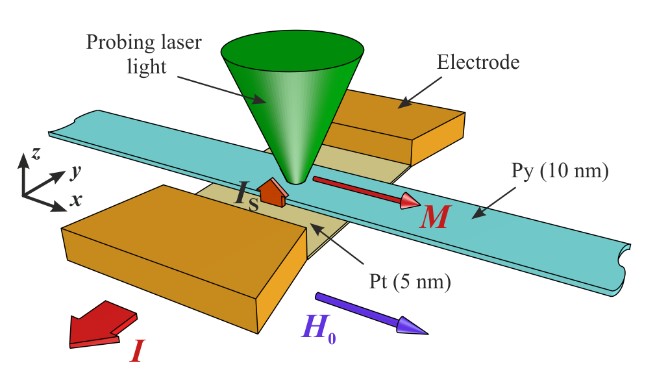 “Chemical potential of quasi-equilibrium magnon gas driven by pure spin current ” Nature Communications, 2017.
In collaboration with the group of Sergej Demokritov at U.Muenster,
we demonstrated that a nanoscale magnetic system subjected to spin current remains in a quasi-equilibrium state, well described by spin current-dependent
thermodynamic parameters - the chemical potential and the effective temperature. Appropriate spin-polarization can lower the effective temperature to 225 K (-48 C).
The opposite spin-polarization increases the chemical potential until it closely approaches the lowest-energy dynamical state,
demonstrating the possibility of spin current-induced room-temperature Bose-Einstein condensation of magnons – a macroscopic quantum-coherent state of the magnetization.
“Chemical potential of quasi-equilibrium magnon gas driven by pure spin current ” Nature Communications, 2017.
In collaboration with the group of Sergej Demokritov at U.Muenster,
we demonstrated that a nanoscale magnetic system subjected to spin current remains in a quasi-equilibrium state, well described by spin current-dependent
thermodynamic parameters - the chemical potential and the effective temperature. Appropriate spin-polarization can lower the effective temperature to 225 K (-48 C).
The opposite spin-polarization increases the chemical potential until it closely approaches the lowest-energy dynamical state,
demonstrating the possibility of spin current-induced room-temperature Bose-Einstein condensation of magnons – a macroscopic quantum-coherent state of the magnetization.
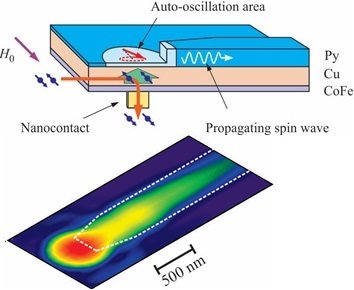 “ Excitation of coherent propagating spin waves by pure spin currents ” Nature Communications, 2016.
In collaboration with the group of Sergej Demokritov at U.Muenster,
we demonstrate a novel nanostructure based on the concepts of nonlocal spin injection and dipolar waveguides. Nonlocal spin injection is an approach
to generating pure spin currents not accompanied by electrical currents, which is very useful for spintronic devices utilizing insulating materials.
Dipolar waveguides developed by us in the last year enable efficient guiding of spin waves in profiled continuous magnetic films.
In this paper, we demonstrated current-induced excitation of coherent spin waves directionally propagating in a dipolar waveguide.
This advancement can enable the development of electronically operated magnonic nano-circuits that can store, transmit and process information, all on the same chip.
“ Excitation of coherent propagating spin waves by pure spin currents ” Nature Communications, 2016.
In collaboration with the group of Sergej Demokritov at U.Muenster,
we demonstrate a novel nanostructure based on the concepts of nonlocal spin injection and dipolar waveguides. Nonlocal spin injection is an approach
to generating pure spin currents not accompanied by electrical currents, which is very useful for spintronic devices utilizing insulating materials.
Dipolar waveguides developed by us in the last year enable efficient guiding of spin waves in profiled continuous magnetic films.
In this paper, we demonstrated current-induced excitation of coherent spin waves directionally propagating in a dipolar waveguide.
This advancement can enable the development of electronically operated magnonic nano-circuits that can store, transmit and process information, all on the same chip.
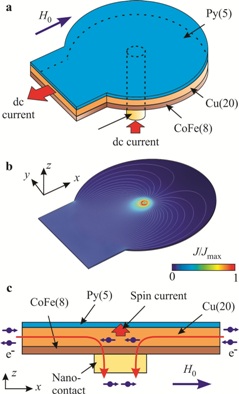 “ Spin-current nano-oscillator based on nonlocal spin injection ” Scientific Reports (2015)
In collaboration with the group of Sergej Demokritov at U.Muenster, we demonstrate the possibility
to induce local oscillations in a magnetic film, by using a pure spin current injected in this film through a nonlocal point contact. Pure spin currents are flows of spin
that are not directly tied to the electrical current. Pure spin currents do not require a concurrent path for the electrical current, provide unprecedented opportunities
for the development of new, previously impossible, architectures of active spintronic devices. Using pure spin currents can also make spintronic devices more efficient,
and minimize the effects of Joule heating and electromigration.
“ Spin-current nano-oscillator based on nonlocal spin injection ” Scientific Reports (2015)
In collaboration with the group of Sergej Demokritov at U.Muenster, we demonstrate the possibility
to induce local oscillations in a magnetic film, by using a pure spin current injected in this film through a nonlocal point contact. Pure spin currents are flows of spin
that are not directly tied to the electrical current. Pure spin currents do not require a concurrent path for the electrical current, provide unprecedented opportunities
for the development of new, previously impossible, architectures of active spintronic devices. Using pure spin currents can also make spintronic devices more efficient,
and minimize the effects of Joule heating and electromigration.
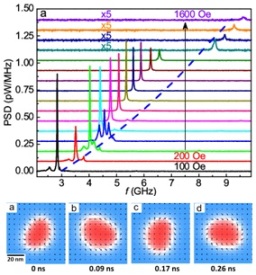 “ Dynamical skyrmion state in spin-current nano-oscillator with perpendicular magnetic anisotropy” PRL,114, 137201 (2015)
We use magnetoelectronic measurements and micromagnetic simulations to demonstrate the possibility to generate a topologically nontrivial nanoscale magnetic texture,
by local injection of spin current into a thin magnetic film with perpendicular anisotropy. Such textures provide a fascinating model system for the elementary particles
studied in high energy physics. They are also among the smallest known magnetic objects, and can provide a medium for the implementation of new magnetic storage and
information processing devices. Previously, skyrmions have been experimentally studied only in bulk noncentrosymmetric crystals. Our research shows a pathway for their
controllable generation and studies in thin-film nanostructures.
“ Dynamical skyrmion state in spin-current nano-oscillator with perpendicular magnetic anisotropy” PRL,114, 137201 (2015)
We use magnetoelectronic measurements and micromagnetic simulations to demonstrate the possibility to generate a topologically nontrivial nanoscale magnetic texture,
by local injection of spin current into a thin magnetic film with perpendicular anisotropy. Such textures provide a fascinating model system for the elementary particles
studied in high energy physics. They are also among the smallest known magnetic objects, and can provide a medium for the implementation of new magnetic storage and
information processing devices. Previously, skyrmions have been experimentally studied only in bulk noncentrosymmetric crystals. Our research shows a pathway for their
controllable generation and studies in thin-film nanostructures.
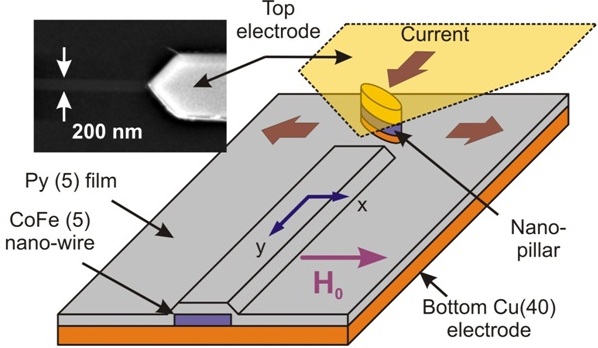 “ Nanomagnonic devices based on the spin transfer torque ”, Nature Nanotech. (2014), also featured in this Journal's
News and Views .
In collaboration with the group of Sergej Demokritov at U. Muenster,
we have proposed and demonstrated a nanoscale magnetic device that consists of a spin-torque nanocontact fabricated into a magnetic medium
with a profiled thickness. In developing this device, we have introduced the concept of a dipolar field-induced dipolar field-induced magnetic nanowaveguides
- magnetic strips with elevated profile whose dipolar fields can confine the propagating spin waves over a frequency range controlled by the geometry of the waveguide.\
This new concept provides a path for the development of magnonic structures that can serve as integrated spin wave-based
filters and logic elements. Good spectral matching between the spin waves emitted by the spin-torque nanocontacts with the appropriately profiled waveguides results in
efficient emission and directional propagation of spin waves, providing the first building block for the spin torque-driven nanomagnonics.
“ Nanomagnonic devices based on the spin transfer torque ”, Nature Nanotech. (2014), also featured in this Journal's
News and Views .
In collaboration with the group of Sergej Demokritov at U. Muenster,
we have proposed and demonstrated a nanoscale magnetic device that consists of a spin-torque nanocontact fabricated into a magnetic medium
with a profiled thickness. In developing this device, we have introduced the concept of a dipolar field-induced dipolar field-induced magnetic nanowaveguides
- magnetic strips with elevated profile whose dipolar fields can confine the propagating spin waves over a frequency range controlled by the geometry of the waveguide.\
This new concept provides a path for the development of magnonic structures that can serve as integrated spin wave-based
filters and logic elements. Good spectral matching between the spin waves emitted by the spin-torque nanocontacts with the appropriately profiled waveguides results in
efficient emission and directional propagation of spin waves, providing the first building block for the spin torque-driven nanomagnonics.
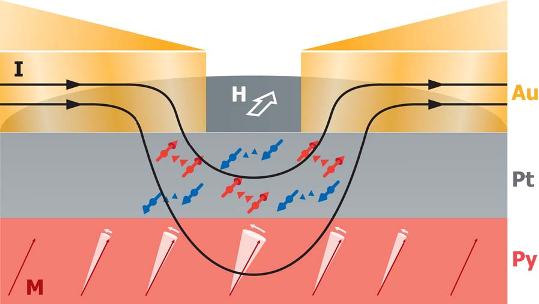 “ Spectral characteristics of microwave emission by a spin Hall nano-oscilaltor ”, PRL (2013), also featured in the
Physics Viewpoint
We have created a nanooscillator utilizing the spin Hall effect to induce microwave-frequency oscillations of a nanoscale magnet, and anisotropic
magnetoresistance effect to convert these oscillations into electronic microwave signals. The simple planar structure of the device is amenable to
a variety of modifications, providing a path for the studies of electron spin physics in nanoscale systems and development of novel active microwave
spintronic nanodevices. Such nanoscale devices can be utilized in microwave communication technologies, as sensitive detectors of dc and microwave fields,
and as local signal sources in magnonic devices.
“ Spectral characteristics of microwave emission by a spin Hall nano-oscilaltor ”, PRL (2013), also featured in the
Physics Viewpoint
We have created a nanooscillator utilizing the spin Hall effect to induce microwave-frequency oscillations of a nanoscale magnet, and anisotropic
magnetoresistance effect to convert these oscillations into electronic microwave signals. The simple planar structure of the device is amenable to
a variety of modifications, providing a path for the studies of electron spin physics in nanoscale systems and development of novel active microwave
spintronic nanodevices. Such nanoscale devices can be utilized in microwave communication technologies, as sensitive detectors of dc and microwave fields,
and as local signal sources in magnonic devices.
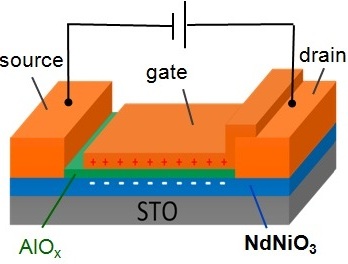 “ Field-effect diode based on electron-induced Mott transition in
NdNiO3 ” APL (2012).
In collaboration with the group of Jaques Chakhalian at U. Arkansas and John Freeland at ANL, we have a field-efect device with diode-like electronic
characteristics achieved due to the electric field-controlled metal-insulator Mott transition in a complex oxide NdNiO2. Because the metal-insulator transition
is of the first order, the electrical characteristics of the device are hysteretic with respect to both the thermal and electrical history of the devices, providing
an additional memristive functionality.
“ Field-effect diode based on electron-induced Mott transition in
NdNiO3 ” APL (2012).
In collaboration with the group of Jaques Chakhalian at U. Arkansas and John Freeland at ANL, we have a field-efect device with diode-like electronic
characteristics achieved due to the electric field-controlled metal-insulator Mott transition in a complex oxide NdNiO2. Because the metal-insulator transition
is of the first order, the electrical characteristics of the device are hysteretic with respect to both the thermal and electrical history of the devices, providing
an additional memristive functionality.
<< Back to Nanoscience at Emory
 “Non-classical spin transfer effects in an antiferromagnet”, PRL 2021.
We utilize simulations of electron scattering by a chain of quantum spins, to demonstrate large contributions to the spin transfer effect in antiferromagnets
(AFs) that cannot be accounted for by the existing semiclassical models of magnetism. AFs are attractive for the development of novel nanomagnetic devices,
since their vanishing magnetization and high characteristic dynamical frequencies may enable fast and low-power device operation. Spin transfer effect – the
transfer of angular momentum from the conduction electrons to the magnetic system – plays a central role in such devices, enabling electronically-driven
rotation of magnetic order. Our results demonstrate the possibility to achieve a substantial enhancement of spin transfer efficiency by taking advantage of
non-classical effects, and suggest the possibility to utilize spin transfer to control purely quantum magnetic systems such as spin liquids.
“Non-classical spin transfer effects in an antiferromagnet”, PRL 2021.
We utilize simulations of electron scattering by a chain of quantum spins, to demonstrate large contributions to the spin transfer effect in antiferromagnets
(AFs) that cannot be accounted for by the existing semiclassical models of magnetism. AFs are attractive for the development of novel nanomagnetic devices,
since their vanishing magnetization and high characteristic dynamical frequencies may enable fast and low-power device operation. Spin transfer effect – the
transfer of angular momentum from the conduction electrons to the magnetic system – plays a central role in such devices, enabling electronically-driven
rotation of magnetic order. Our results demonstrate the possibility to achieve a substantial enhancement of spin transfer efficiency by taking advantage of
non-classical effects, and suggest the possibility to utilize spin transfer to control purely quantum magnetic systems such as spin liquids.




 Among the general themes in modern science are the new fundamental phenomena and functionalities that emerge in "designer" materials and structures.
Is it possible to form a new magnetic state of matter by putting together two materials exhibiting well-known magnetic phases, such as a ferromagnet (F) and an antiferromagnet (AF)?
We gave a positive answer to this question in a series of papers,
Among the general themes in modern science are the new fundamental phenomena and functionalities that emerge in "designer" materials and structures.
Is it possible to form a new magnetic state of matter by putting together two materials exhibiting well-known magnetic phases, such as a ferromagnet (F) and an antiferromagnet (AF)?
We gave a positive answer to this question in a series of papers, 









